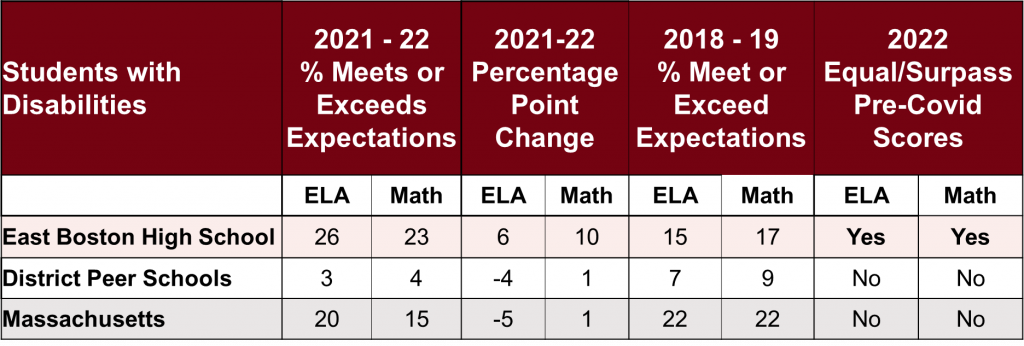Getting back to pre-pandemic levels
by Joan Reissman and Gary Kaplan
Educators everywhere are working hard to bring students back up to pre-pandemic achievement levels. The brightest spotlight remains focused on equitable outcomes for at-risk groups. In a previous post, MCAS Maven Joan Reissman illustrated that East Boston High School achieved results on the 2022 10th grade MCAS that were higher than their peer group of open enrollment district high schools, and logged substantial gains over 2021. But has EBHS returned to – or even exceeded – pre-pandemic achievement levels? And if so, how did they do it?
East Boston High School, “Eastie,” is a traditional urban high school, and a JFYNetWorks partner since 2014-15. There are far more traditional comprehensive high schools statewide and nationally, enrolling more students, than any other type. In the Boston Public School district, there are 16 open enrollment schools that share a central administration and budget and draw from the same population pool without restrictions on admission. Consistency of operating conditions increases the validity of comparisons among these schools by reducing external variables. Unlike exam, selective admission, pilot or charter schools, schools in other districts, or regional vocational schools, these 16 open enrollment schools all play on the same field by the same rules.
There are some notable differences in Eastie’s student population compared to the district and the state. The school population includes 93% “high needs” students—a composite term that includes current and former English Learners, low-income students and students with disabilities. It also hosts 81.5% Hispanic/Latino students. Eastie’s concentration of these groups is higher than the district as a whole and higher than the state. (There are not enough African American students to constitute a DESE-designated subgroup.)

Here we examine these four historically lower-performing groups. To measure the one-year gain and the three-year gain, encompassing pandemic learning loss, we assessed two intervals: 2021 to 2022, and 2019 to 2022, to see if EBHS has regained pre-pandemic performance levels.

Hispanic/Latino students, who are 82% of the school, outperformed their cohort in other open enrollment schools in the district, with double digit gains in math. In addition, these students met or surpassed pre-pandemic scores in both ELA and math — outstanding performance compared to the district and the state.

Low income students, 82% of Eastie’s population, also outperformed other open enrollment schools in the district, with even higher one-year double-digit gains in math, missing the pre-pandemic score by only 4 points. Low income students across the district and state fell short of pre-pandemic scores by 9 and 6 points respectively.

Among students whose first language is not English, Eastie’s one-year gains and its scores exceeded the district group, while its pre-pandemic recovery rate was in line with the district and the state.

Students with disabilities also had double-digit increases in math scores (along with low income and Hispanic/Latino students). In both ELA and math these students far outperformed their peers in the district open enrollment schools, and exceeded the state scores. They closed the pre-Covid gap in ELA and came within 2 points in math.
How did they do it? See our recent post, Digging Deeper into East Boston High: The secret sauce of success to learn more about Eastie’s journey to achieve equitable outcomes for high needs students.
How we work with you
JFYNetWorks supports classroom instruction using our unique AIMS methodology to customize online curriculum aligned to Massachusetts state standards for teachers’ and students’ specific requirements. Our teacher-directed blended learning approach offers anywhere, anytime scaffolded tutoring to address identified student needs. The JFY platform includes practice testing and provides specialized adaptations for English learners and students with disabilities.
Our commitment to equitable student outcomes is supported by our team of experienced Learning Specialists who are available to your teachers by email, text and phone and through in-person consultations. We empower teachers to use all our tools to help each student become more engaged in learning and more proficient in ELA and math. Your school’s JFY Learning Specialist monitors student progress and offers recommendations on curriculum and instructional strategies throughout the year.
As you look ahead to spring MCAS testing, consider how JFY might help your high needs students, and all your students. We are fortunate to have funding to offer your middle and high schools our proven solution to closing achievement gaps at no cost to your budget. We’d be glad to talk with you. Just schedule an appointment with Executive Director Gary Kaplan.
Joan Reissman, the MCAS Maven, is a JFYNetWorks learning specialist.
Gary Kaplan is the JFYNetWorks executive director.
HOW ARE WE DOING? In our pursuit to serve up content that matters to you, we ask that you take a couple of minutes to let us know how we’re doing? Please click here to be navigated to our JFYNet Satisfaction Survey. Thank you!





